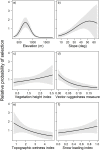Steep and deep: Terrain and climate factors explain brown bear (Ursus arctos) alpine den site selection to guide heli-skiing management
- PMID: 32966287
- PMCID: PMC7511016
- DOI: 10.1371/journal.pone.0238711
Steep and deep: Terrain and climate factors explain brown bear (Ursus arctos) alpine den site selection to guide heli-skiing management
Abstract
Winter recreation and tourism continue to expand worldwide, and where these activities overlap with valuable wildlife habitat, there is greater potential for conservation concerns. Wildlife populations can be particularly vulnerable to disturbance in alpine habitats as helicopters and snowmachines are increasingly used to access remote backcountry terrain. Brown bears (Ursus arctos) have adapted hibernation strategies to survive this period when resources and energy reserves are limited, and disturbance could negatively impact fitness and survival. To help identify areas of potential conflict between helicopter skiing and denning brown bears in Alaska, we developed a model to predict alpine denning habitat and an associated data-based framework for mitigating disturbance activities. Following den emergence in spring, we conducted three annual aerial surveys (2015-2017) and used locations from three GPS-collared bears (2008-2014) to identify 89 brown bear dens above the forest line. We evaluated brown bear den site selection of land cover, terrain, and climate factors using resource selection function (RSF) models. Our top model supported the hypothesis that bears selected dens based on terrain and climate factors that maximized thermal efficiency. Brown bears selected den sites characterized by steep slopes at moderate elevations in smooth, well-drained topographies that promoted vegetation and deep snow. We used the RSF model to map relative probability of den selection and found 85% of dens occurred within terrain predicted as prime denning habitat. Brown bear exposure to helicopter disturbance was evident as moderate to high intensities of helicopter flight tracking data overlapped prime denning habitat, and we quantified where the risk of these impact was greatest. We also documented evidence of late season den abandonment due to disturbance from helicopter skiing. The results from this study provide valuable insights into bear denning habitat requirements in subalpine and alpine landscapes. Our quantitative framework can be used to support conservation planning for winter recreation industries operating in habitats occupied by denning brown bears.
Conflict of interest statement
The authors declare that no competing interests exist.
Figures





References
-
- Hagenstad M, Burakowski E, Hill R. Economic contributions of winter sports in a changing climate. Boulder, CO: Protect Our Winters; 2018. https://scholars.unh.edu/cgi/viewcontent.cgi?article=1190&context=ersc.
-
- Patthey P, Wirthner S, Signorell N, Arlettaz R. Impact of outdoor winter sports on the abundance of a key indicator species of alpine ecosystems. J Appl Ecol. 2008;45(6):1704–11. 10.1111/j.1365-2664.2008.01547.x - DOI
-
- Thiel D, Jenni-Eiermann S, Braunisch V, Palme R, Jenni L. Ski tourism affects habitat use and evokes a physiological stress response in capercaillie Tetrao urogallus: a new methodological approach. J Appl Ecol. 2008;45(3):845–53. 10.1111/j.1365-2664.2008.01465.x - DOI
Publication types
MeSH terms
Associated data
LinkOut - more resources
Full Text Sources
Other Literature Sources

